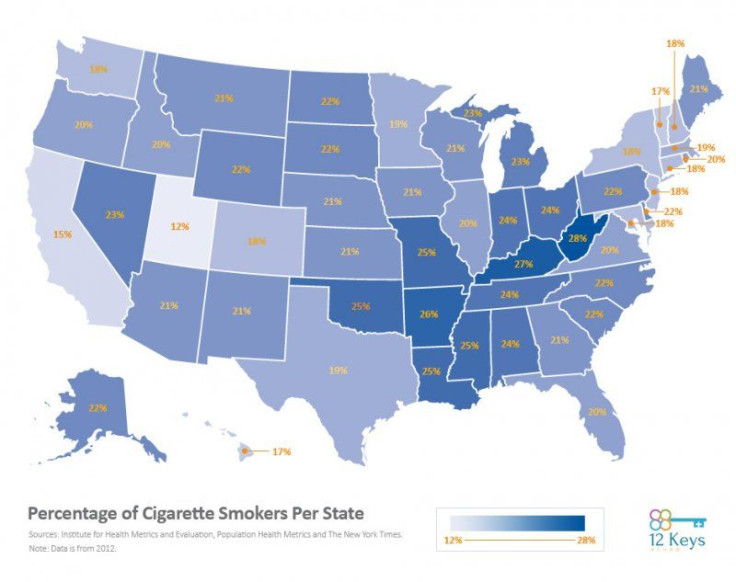Cigarette Smoking Rates By State: Are There A Lot Of Smokers Near You?

Who are the leaders of the pack in your state? The most recent cigarette-smoking statistics are been laid out on a map, giving people an easily comparable nationwide perspective of who the top smokers were in 2012. The data, which was based on the Institute for Health Metrics and Evaluation, Population Health Metrics, and The New York Times, reveals the percentage of smokers in each state.
West Virginia stands at the high end with 28.3 percent of its state residents smoking, while Utah comes in at only 10.6 percent in comparison. The percentages mean more when population is taken into consideration: Utah only has a population of 342,600 residents, and West Virginia not only has a large percentage of its population smoking, but it also has considerably more residents — 519,400.
Previously, state-for-state comparisons in 2009 ranked Kentucky as the number one most smoking state, which bumped West Virginia down to number two. Utah remained the same, with the least amount of smoking residents.
Maybe it’s no coincidence that West Virginia has the high percentage of smokers and is ranked in the bottom five for the least expensive cigarettes at $5.07 per pack. New York state is ranked fairly low, with only 18 percent of its residents as smokers, but its cigarette prices are more than double that of West Virginia, at $14.50 a pack, according to The Awl. This inverse relationship between the amount of smokers and the price it costs to keep up the harmful habit can be seen throughout the country, which supports the idea that taxes deter from usage.
Currently, more than 16 million Americans suffer from a disease caused by either first or secondhand smoking. Cigarette smoking is the leading cause of preventable death in the United States, which steals more than 480,000 lives, or accounts for one out of every five deaths, every single year.
The dangers of smoking cigarettes are undeniable and widely well-known, but tobacco industries spend almost $23 million dollars every day to make sure to keep their consumers hooked. Throughout the year, it winds up costing them $8.4 billion, according to the Centers for Disease Control and Prevention (CDC), however tobacco use costs the United States more than $289 billion in direct medical costs and lost productivity each year, making it a lose-lose for everyone’s health and back account. It’s estimated that smokers die 10 years earlier than nonsmokers.
There are an estimated total of 42.1 million cigarette smokers in the United States, which averages all the states together to 18.1 percent of all adults, aged 18 years or older, according to the CDC. Men tend to be the smokers; across the board, 20.5 percent of men are smokers, while only 15.8 percent are women.
But it’s not just the smokers, but also the secondhand smokers that have to suffer, which is why it’s important to know the health climate of the state you live in because it creates your breathing environment. Secondhand smoke is also known as environmental tobacco smoke (ETS) and is a mixture of the “sidestream smoke,” which is the smoke burning from the tobacco at the end of the cigarette, as well as the “mainstream” smoke exhaled by the smoker. Both contain cancer-causing agents, known as carginogens, but sidestream smoke contains a larger quantity. Mainstream smoke’s particles are smaller and can more easily make their way into a non-smoker’s cells.
According to the American Lung Association, if you are a smoker, live with a smoker, or are in a smoke-filled state where the percentage is very high, you’re at a higher risk for the following:
- Respiratory infections (like bronchitis and pneumonia)
- Asthma (secondhand smoke is a risk factor for the development of asthma and can trigger attacks in those who already have it)
- Coughing, sore throats, sniffling, and sneezing
- Chronic coughing, phlegm, and wheezing
- Chest discomfort
- Lowered lung function
- Eye and nose irritation
- Severe and chronic heart disease
- Middle ear infections in children
- Sudden infant death syndrome (SIDS)
- Low birth weight or small size at birth for babies of women exposed to secondhand smoke during pregnancy
- Cancer
- Stroke



























